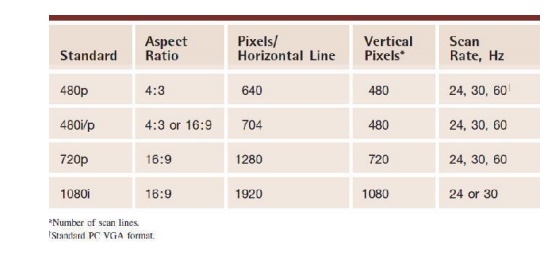Chapter: Television and Video Engineering : Advanced Television Systems
Digital TV (DTV)
Digital TV (DTV)
Digital
TV (DTV), also known as high-definition TV (HDTV), was designed to replace the
National Television Standards Committee (NTSC) system, which was invented in
the 1940s and 1950s.
The goal
of HDTV is to greatly improve the picture and sound quality. After more than a
decade of evaluating alternative HDTV systems, the FCC has finalized the
standards and decreed that HDTV will eventually become the U.S. TV standard by
April 2009.
The first
HDTV stations began transmission in the 10 largest U.S. cities on September 1,
1998. HDTV sets can now be purchased by the consumer, but they are still
expensive. As more HDTV stations come online and as more HDTV programming
becomes available, more consumers will buy HDTV receivers and the cost will
drop dramatically.
The HDTV
system is an extremely complex collection of digital, communication and
computer techniques.
A full
discussion is beyond the scope of this book. However, this section is a brief
introduction to the basic concepts and techniques used in HDTV. HDTV Standards
HDTV for the United States was developed by the Advanced Television Systems
Committee (ATSC) in the 1980s and 1990s.
HDTV uses
the scanning concept to paint a picture on the CRT, so you can continue to
think of the HDTV screen in terms of scan lines, as you would think of the
standard NTSC analog screen. However, you should also view the HDTV screen as
being made up of thousands of tiny dots of light, called pixels.
Each
pixel can be any of 256 colors. These pixels can be used to create any image.
The greater the number of pixels on the screen, the greater the resolution and
the finer the detail that can be represented.
Each
horizontal scan line is divided into hundreds of pixels. The format of a HDTV
screen is described in terms of the numbers of pixels per horizontal line by
the number of vertical pixels (which is the same as the number of horizontal
scan lines).
One major
difference between conventional NTSC analog TV and HDTV is that HDTV can use
progressive line scanning rather than interlaced scanning. In progressive
scanning each line is scanned one at a time from top to bottom.
Since
this format is compatible with computer video monitors, it is possible to
display HDTV on computer screens. Interlaced scanning can be used on one of the
HDTV formats. Interlaced scanning minimizes flicker but complicates the video
compression process. Progressive scanning is preferred and at a 60-Hz frame
rate, flicker is not a problem.

The FCC
has defined a total of 18 different formats for HDTV. Most are variations of
the basic formats as given in Table. Most plasma, LCD and larger screens only
display these formats.The 480p (the p
stands for “progressive”) standard offers performance comparable to that of the
NTSC system. It uses a 4:3 aspect ratio for the screen.
The
scanning is progressive. The vertical scan rate is selectable to fit the type
of video being transmitted. This format is fully compatible with modern VGA
computer monitors.
The
format can use either progressive or interlaced scanning with either aspect
ratio at the three vertical scan rates shown in Table.
The 720p
format uses a larger aspect ratio of 16:9 (a 4:3 format is optional at this
resolution also). This format is better for showing movies. Figure shows the
difference between the current and new HDTV aspect ratios.
The 1080i
format uses the 16:9 aspect ratio but with more scan lines and more pixels per line.
This format obviously gives the best resolution. The HDTV set should be able to
detect and receive any available format. The 720p at 60 Hz and 1080i formats
are those designated HDTV.
Related Topics